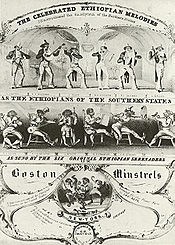
Ethiopian Serenaders
Encyclopedia

Blackface
Blackface is a form of theatrical makeup used in minstrel shows, and later vaudeville, in which performers create a stereotyped caricature of a black person. The practice gained popularity during the 19th century and contributed to the proliferation of stereotypes such as the "happy-go-lucky darky...
minstrel
Minstrel show
The minstrel show, or minstrelsy, was an American entertainment consisting of comic skits, variety acts, dancing, and music, performed by white people in blackface or, especially after the Civil War, black people in blackface....
troupe from the 1840s. Their first major performance was for John Tyler
John Tyler
John Tyler was the tenth President of the United States . A native of Virginia, Tyler served as a state legislator, governor, U.S. representative, and U.S. senator before being elected Vice President . He was the first to succeed to the office of President following the death of a predecessor...
at the White House in 1844 as part of the "Especial Amusement of the President of the United States, His Family and Friends". After this success, the troupe altered its act to make it more "refined" and to appeal to a higher-class audience than had traditionally patronized blackface entertainment. They billed their shows as blackface "concert
Concert
A concert is a live performance before an audience. The performance may be by a single musician, sometimes then called a recital, or by a musical ensemble, such as an orchestra, a choir, or a musical band...
s" and added songs of a sentimental, romantic nature, even going so far as to perform pieces from popular opera
Opera
Opera is an art form in which singers and musicians perform a dramatic work combining text and musical score, usually in a theatrical setting. Opera incorporates many of the elements of spoken theatre, such as acting, scenery, and costumes and sometimes includes dance...
s. In exchange, they cut bawdy, humorous material like that used by the Virginia Minstrels
Virginia Minstrels
The Virginia Minstrels or Virginia Serenaders was a group of 19th century American entertainers known for helping to invent the entertainment form known as the minstrel show...
and other troupes.
The Serenaders saw great success with this formula and left for a tour in England
England
England is a country that is part of the United Kingdom. It shares land borders with Scotland to the north and Wales to the west; the Irish Sea is to the north west, the Celtic Sea to the south west, with the North Sea to the east and the English Channel to the south separating it from continental...
beginning in 1846, often performing at the St. James's Theatre for their London seasons. In England, they were frequently mistaken for real black men, a misconception they always denied, asserting that they had not the "least drop of black blood in their veins"; accordingly, "they lost no time in published portraits of themselves with the white faces bestowed upon them by nature." In their absence, rivals such as the Christy Minstrels had gained a following in the United States. Upon their return from England in 1847, the Spirit of the Times
Spirit of the Times
The Spirit of the Times: A Chronicle of the Turf, Agriculture, Field Sports, Literature and the Stage was an American weekly newspaper published in New York City. The paper aimed for an upper-class readership made up largely of sportsmen. The Spirit also included humorous material, much of it based...
wrote that the Serenaders formal style in music and dress was too refined for audiences accustomed to the ribald humor of the Christys. Of a Serenaders performance, the article said, ". . . we listen and are pleased but leave with little desire to return." At Christys, "we listen and laugh and desire to go again and again." The Serenaders eventually returned to London, this time with the addition of William Henry Lane, a black man known as "Master Juba
Master Juba
Master Juba was an African American dancer active in the 1840s. He was one of the first black performers in the United States to play onstage for white audiences and the only one of the era to tour with a white minstrel group...
". The minstrel show remained popular in England through the end of the 19th century.

